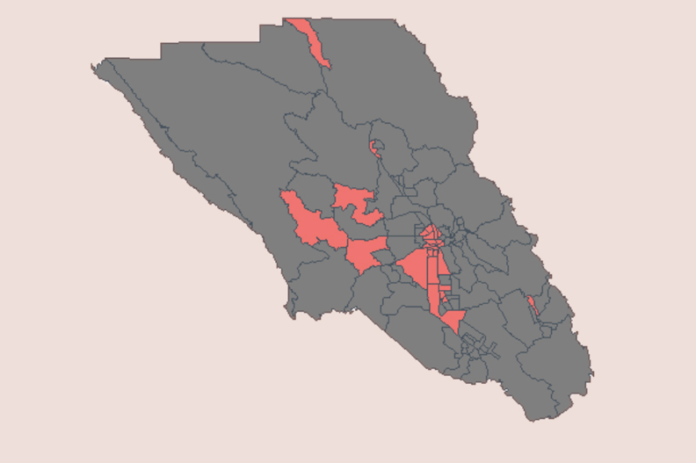At their meeting on Oct. 20, the Sonoma County Board of Supervisors voted unanimously to allocate approximately $4 million to support an enhanced series of strategies to assist with outreach to COVID-19 case curbing in at-risk communities.
During the supervisor’s budget workshop earlier this year, the director of health services presented an overview of a plan to allow for a sustainable COVID-19 response through June 30, 2021. At that meeting, the director presented an update of the continuing COVID-19 response efforts with a request for funding alongside a proposed plan for replacing the Health Department Operations Center (DOC) with a temporary Novel Coronavirus/COVID-19 Section within the Public Health Division.
The focus of this discussion was related to creating a strategic plan for underserved communities who have been disproportionately effected by the COVID-19 pandemic.
The numbers
The initial presentation was given by Sonoma County’s Health Officer Dr. Sundari Mase and Barbie Robinson, the director of Sonoma County Department of Health and the interim executive director of the Community Development Commission.
Mase began the presentation by discussing the three metrics that the state uses for determining a county’s placement in the tier system of the Blueprint for a Safer Economy. The first is the daily new case rate per 100,000. The second is the percentage of positive tests. The third is whether or not the virus is disproportionately impacting certain communities.
Specifically, the state uses something called the Health Places Index (HPI) to measure the factors that predict life expectancy, including things like income, housing security, education and more. They then assign a score using that index to each census tract in the county. To move tiers, testing positivity numbers in the bottom 25% of HPI-scored tracts “must meet the criteria of the new tier to which the county hopes to advance.”
In other words, if the overall numbers or good, but those of the most at-risk communities are not, the county will not be able to move tiers.
As of the meeting, Sonoma County/s daily transmission rate was 13 new cases per 100,000. The number needed to move down into the next tier, the red tier, is 7 or fewer. In addition, the county’s number represents a trend of the last few weeks of increasing numbers, after reaching a low of 10.
The county does meet the test positivity number to move down into the red tier, with a current number of 5.1%, and 7.5% for underserved communities. While both of those put the county in the red tier range, the high daily case number is preventing the county from moving out of the tier. However, if both of the positivity numbers fall down into the next lowest tier, orange, the county would be able to split the difference and move into the red tier.
Based on a map shown during the presentation, most of these tracts are located in Santa Rosa and Rohnert Park, but there are some in west county/the river area, as well as Cloverdale. Among the ways that that socioeconomic inequalities impact some groups disproportionately include an inability for essential workers living on a limited income to quarantine or miss work, , living in congregate housing, often with shared transportation, lack of access to health care and childcare as well as wariness of contact tracing and government services such as alternative care sites.
The plans
The six strategies being funded by this plan include: expanded intensive and data driven testing; enhanced outreach to the Latinx community; incentive program/financial assistance incentives; partnerships with the business community; isolation/quarantine support including hotel accommodations and wrap-around services; and a communication and promotion campaign.
Strategy 1: Expanded testing opportunities
Beginning Oct. 19, the county has doubled testing, with pop-up testing sites in places like Andy’s Unity Park, Healdsburg Day Labor Center, the Roseland and Rohnert Park Libraries and more. The neighborhoods being targeted for these tests are the census tracts identified as being in the bottom 25% of the HPI.
The plan involves up to 12 testing sites a week, with a goal of 400 tests per day with a 48-hour turnaround for results. As the program expands, new areas will be added as testing sites.
The timeline presented a three-phase implementation, which is space between now and June 30, with additional hires coming on line and building up to the 400 test-a-day goal.
Strategy 2: Enhanced outreach to the Latinx community
The county Health Services Department has contracted with local community program On The Move to implement a large-scale outreach and education campaign to Latinx and Indigenous communities. This program, known at CURA (COVID-19 Urgent Response and Aid) will “support multiple avenues of outreach and support” and is steered by On The Move’s La Plaza: Nuestra Cultura Cura and utilizes family resources centers and other agencies embedded within the community.
Some of the services offered by CURA include doing direct outreach to farmworkers, laborers and other Latinx and Indigenous communities, making sure high-risk workers have access to PPE, connecting individuals to medical supportive services doing outreach for the testing events and providing emergency financial assistance.
The passage of this measure will not change their services, rather it will allow continued expansion of the programs throughout the county.
Strategy 3: Incentive program/financial assistance incentives
To increase the volume of the target population being tested, the county will offer an incentive in the form of a $30 gift card for all individuals in the target census tracts who get tested for coronavirus.
Eligibility for cards will be limited to once per month. Monetary testing incentives such as this have been successful in significantly increasing testing for other infectious and communicable diseases (e.g. tuberculosis, syphilis) amongst disenfranchised populations. Health officials estimate an increased demand for testing by approximately 50-75% in the target groups based on data from other similar interventions.
They would only be available at testing sites in the targeted census tracts.
In addition, there will be work done to assist with lost Income replacement for those infected, to allow them to stay home and prevent the spread of the disease.
The local plan would be to focus on providing lost wage replacement to the most vulnerable community members who do not have access to other forms of coverage (i.e., paid sick leave, employer compensation) and who would suffer significant economic hardship as a result of being quarantined.
There will be targeted populations, and aid will be given to different groups based on need and financial availability. The basic compensation would be based on a minimum wage of $15.20 (the highest in the county) and a 40-hour work week. Since standard quarantine is two weeks, individuals would be paid for two weeks/80 hours or a one-time payment of $1,216.
The first tier of those eligible for compensation would be for confirmed adult COVID-19 cases with no access to paid leave or other compensation who live in lowest quartile census tracts or whose household income is below the poverty line, including laborers, independent contractors, people who are paid under the table and undocumented workers. Confirmed homeless COVID-19 cases would also fall into this tier.
The second tier is dependent on funding but includes adult contacts of confirmed cases who are required to quarantine for 14 days. Individuals must be 18 or more years of age; cannot be eligible for unemployment or receive paid sick leave; must live in a lowest quartile census tract or have an annual income less than 80% of Sonoma County median income.
Strategy 4: Partnerships with business community
The DHS will work with the Economic Development Board (EDB) and other key businesses and industries to have enhanced worker education on infection control and prevention and share information on testing and incentive programs available.
Areas the DHS envisions these public/private partnerships would have real impact supporting testing, including at places of employment, sponsorship or support of testing and isolating, and modeling best practices.
Strategy 5: Provide isolation and quarantine support
The county hopes to secure 35 additional hotel rooms for isolation closer to the targeted census tracts, since they’ve received significant feedback that the underutilization of current Alternative Care Sites (ACS’) is because of their lack of proximity to the homes of subjects. They plan to consult with members of the Latinx Health Workgroup to “enhance the cultural appropriateness of ACS space.”
They also plan to provide gift cards to those isolated in ACS’ and provide wrap around services, including medication and meal and grocery deliveries and laundry services as needed.
Strategy 6: Create communications/education campaign
The final strategy involves creating a new communication and outreach plan in Spanish and English, including geo-targeted digital advertising, to promote the above programs. In particular, the county wants to promote the increased testing, make sure people are aware of the financial supports available and they want to suggest people exercise caution for holiday family gatherings. The tagline being promoted is “Mask Up, Back Up, and Wash Up. Don’t Let Up!”
The cost
The proposed plan represents additional costs to the plan approved by the Board of Supervisors on Sept. 1. The total plan cost from Oct. 20, 2020 to June 30, 2021 is estimated at $15.9 million and covers all six strategies. This proposal would redirect $4 million of CARES funding from the COVID-19 Response Plan to the Enhanced COVID-19 Strategies to be used through Dec. 30, 2020. The department will come back to the Board of Supervisors at a later date to request funding of $11.9 million to fund the Enhanced COVID-19 Strategies from the Dec. 31, 2020 through June 30, 2021.
The cost of the plan didn’t faze the board of supervisors.
“I don’t think $15 million is too much at all to invest,” said supervisor Shirlee Zane. “If we don’t, we’re going to lose a lot more; people move out, businesses shut down, we’ll have more impacts to hospitality, ag and the winery industry. I think it’s a small amount, not over the top at all, and I hope it works. If it doesn’t, then we should think about investing even more. I’m looking forward to leaving purple and sliding into home base.”
The board was universally supportive of the plan, and the majority of their questions were passed on from constituents about the pandemic itself, rather than strategies or plans for CURA. Similarly, the public comments were mostly related to a belief that COVID-19 is a hoax, rather than related to the plan that was being presented.









